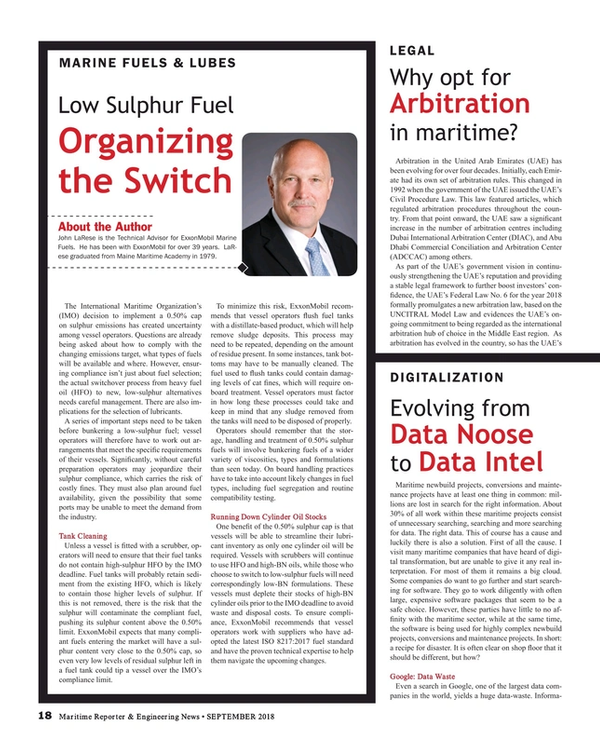
Marine Low Sulphur Fuel: Organizing the Switch
The International Maritime Organization’s (IMO) decision to implement a 0.50 percent cap on sulphur emissions has created uncertainty among vessel operators. Questions are already being asked about how to comply with the changing emissions target, what types of fuels will be available and where. However, ensuring compliance isn’t just about fuel selection; the actual switchover process from heavy fuel oil (HFO) to new, low-sulphur alternatives needs careful management. There are also implications for the selection of lubricants.
A series of important steps need to be taken before bunkering a low-sulphur fuel; vessel operators will therefore have to work out arrangements that meet the specific requirements of their vessels. Significantly, without careful preparation operators may jeopardise their sulphur compliance, which carries the risk of costly fines. They must also plan around fuel availability, given the possibility that some ports may be unable to meet the demand from the industry.
Tank Cleaning
Unless a vessel is fitted with a scrubber, operators will need to ensure that their fuel tanks do not contain high-sulphur HFO by the IMO deadline. Fuel tanks will probably retain sediment from the existing HFO, which is likely to contain those higher levels of sulphur. If this is not removed, there is the risk that the sulphur will contaminate the compliant fuel, pushing its sulphur content above the 0.50 percent limit.
ExxonMobil expects that many compliant fuels entering the market will have a sulphur content very close to the 0.50 percent cap, so even very low levels of residual sulphur left in a fuel tank could tip a vessel over the IMO’s compliance limit.
To minimize this risk, ExxonMobil recommends that vessel operators flush fuel tanks with a distillate-based product, which will help remove sludge deposits. This process may need to be repeated, depending on the amount of residue present. In some instances, tank bottoms may have to be manually cleaned.
The fuel used to flush tanks could contain damaging levels of cat fines, which will require on-board treatment. Vessel operators must factor in how long these processes could take and keep in mind that any sludge removed from the tanks will need to be disposed of properly.
Operators should remember that the storage, handling and treatment of 0.50 percent sulphur fuels will involve bunkering fuels of a wider variety of viscosities, types and formulations than seen today. On-board handling practices have to take into account likely changes in fuel types, including fuel segregation and routine compatibility testing.
Running Down Cylinder Oil Stocks
One benefit of the 0.50 percent sulphur cap is that vessels will be able to streamline their lubricant inventory as only one cylinder oil will be required. Vessels with scrubbers will continue to use HFO and high-BN oils, while those who choose to switch to low-sulphur fuels will need correspondingly low-BN formulations. These vessels must deplete their stocks of high-BN cylinder oils prior to the IMO deadline to avoid waste and disposal costs.
To ensure compliance, ExxonMobil recommends that vessel operators work with suppliers who have adopted the latest ISO 8217:2017 fuel standard and have the proven technical expertise to help them navigate the upcoming changes.
About the Author
John LaRese is the Technical Advisor for ExxonMobil Marine Fuels. He has been with ExxonMobil for over 39 years. Most of his career was spent onboard affiliate Tankers as a Chief Engineer, sailing onboard affiliate VLCCs, Product and Chemical Tankers. Since coming onshore, he has had a number of other assignments such as an Energy Conservation Specialist, Contract Negotiator, Ships Superintendent, Fleet Operations Support Manager, auditor and trainer of senior officers specializing in vessel management and safety. He has been ExxonMobil’s Marine Fuels Technical Manager since 2009. A large portion of his current position focuses on the development of 0.5% Sulphur Compliant Marine Fuels. LaRese graduated from Maine Maritime Academy in 1979 with a B.S. in Marine Engineering
Read Marine Low Sulphur Fuel: Organizing the Switch in Pdf, Flash or Html5 edition of September 2018 Maritime Reporter
Other stories from September 2018 issue
Content
- Maritime Accidents & Confidential near-miss Reporting page: 10
- Port of San Juan: A Case Study in Port Security Innovation page: 12
- ECDIS & Maritime Accident Investigation page: 14
- Marine Low Sulphur Fuel: Organizing the Switch page: 18
- Maritime Welfare Training: More Important than Ever page: 20
- Mariner Training in Brazil: Inside the Institute of Nautical Sciences page: 28
- Maritime Ports Pushed to Up Cyber Security page: 32
- Maritime Industry's Slow Boat to Cyber Security page: 37
- NASA Welding Technologies Could Revolutionize Workboat Fabrication page: 42
- Maritime Response Services & Non-Tank Vessel Response Plans page: 48


